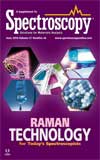Supplementary Information: Polarized Raman Spectroscopy of Aligned Semiconducting Single-Walled Carbon Nanotubes
Special Issues
This information is a supplementary to the article “Polarized Raman Spectroscopy of Aligned Semiconducting Single-Walled Carbon Nanotubes” that was published in the June 2016 Spectroscopy supplemental issue Raman Technology for Today’s Spectroscopists (1).
This information is supplementary to the article “Polarized Raman Spectroscopy of Aligned Semiconducting Single-Walled Carbon Nanotubes” that was published in the June 2016 Spectroscopy supplemental issue Raman Technology for Today’s Spectroscopists (1).
Optical Anisotropy Calculation in Figure 4
One way of using the Raman imaging data is to obtain an average reading for a larger area of the sample compared to a single point measurement. The boxed areas in Figure 4 represent areas where the Raman spectral measurements were averaged to produce a single Raman spectrum. The boxed area in Figure 4 on the left is an area of unaligned SWCNTs; the boxed area on the right is an area of aligned SWCNTs.
Each boxed area in Figure 4 is 11 x 47 µm (517 sq. µm) with spectra collected at a spatial resolution (pixel size) of 0.3 µm; this comes out to ~1800 individual spectra. Therefore, each boxed area produces a single Raman spectrum representing the averaged sample area. We calculated the peak area of the G-Band from the averaged spectrum collected at each polarization configuration (V_V, H_H) and took the ratio. A correction factor was applied to compensate for the reduced optical throughput in the H_H configuration. This correction factor is calculated from the silicon peak at 519 cm-1 Raman shift which is not sensitive to polarization.
Aligned s-SWCNTs Region:


Randomly-Oriented s-SWCNTs Region:

Therefore, the average optical anisotropy value for the aligned s-SWCNTs is ≈22 and for randomly oriented s-SWCNTs is ≈1.4.
Orientation Image in Figure 5
The V_V and H_H polarization images were exported from OMNICxi as grayscale TIFF images having the same intensity scale. This preserved the relative numerical values of each pixel between the two images. The TIFF images were imported into ImageJ where the subsequent orientation image was created by dividing the V_V image by the H_H image (3). The resulting image was scaled by a factor of 0.882 to correct for the lower instrument throughput caused by additional polarization optics (half wave plate) when collecting the H_H image.
References
- A. Mashal, D. Wieboldt, K. Jinkins, and M.S. Arnold, Spectroscopy31(s6), 36–44 (2016).
- Y. Joo, G. Brady, M. Arnold, and P. Gopalan, American Chemical Society, 3460–3466 (2014).
- J. Schindelin, et al., Nature Methods9(7), 676–682, PMID 22743772 (2012).

LIBS Illuminates the Hidden Health Risks of Indoor Welding and Soldering
April 23rd 2025A new dual-spectroscopy approach reveals real-time pollution threats in indoor workspaces. Chinese researchers have pioneered the use of laser-induced breakdown spectroscopy (LIBS) and aerosol mass spectrometry to uncover and monitor harmful heavy metal and dust emissions from soldering and welding in real-time. These complementary tools offer a fast, accurate means to evaluate air quality threats in industrial and indoor environments—where people spend most of their time.
NIR Spectroscopy Explored as Sustainable Approach to Detecting Bovine Mastitis
April 23rd 2025A new study published in Applied Food Research demonstrates that near-infrared spectroscopy (NIRS) can effectively detect subclinical bovine mastitis in milk, offering a fast, non-invasive method to guide targeted antibiotic treatment and support sustainable dairy practices.
Smarter Sensors, Cleaner Earth Using AI and IoT for Pollution Monitoring
April 22nd 2025A global research team has detailed how smart sensors, artificial intelligence (AI), machine learning, and Internet of Things (IoT) technologies are transforming the detection and management of environmental pollutants. Their comprehensive review highlights how spectroscopy and sensor networks are now key tools in real-time pollution tracking.